Wonjae Shin
PC-DeepNet: A GNSS Positioning Error Minimization Framework Using Permutation-Invariant Deep Neural Network
Apr 18, 2025Abstract:Global navigation satellite systems (GNSS) face significant challenges in urban and sub-urban areas due to non-line-of-sight (NLOS) propagation, multipath effects, and low received power levels, resulting in highly non-linear and non-Gaussian measurement error distributions. In light of this, conventional model-based positioning approaches, which rely on Gaussian error approximations, struggle to achieve precise localization under these conditions. To overcome these challenges, we put forth a novel learning-based framework, PC-DeepNet, that employs a permutation-invariant (PI) deep neural network (DNN) to estimate position corrections (PC). This approach is designed to ensure robustness against changes in the number and/or order of visible satellite measurements, a common issue in GNSS systems, while leveraging NLOS and multipath indicators as features to enhance positioning accuracy in challenging urban and sub-urban environments. To validate the performance of the proposed framework, we compare the positioning error with state-of-the-art model-based and learning-based positioning methods using two publicly available datasets. The results confirm that proposed PC-DeepNet achieves superior accuracy than existing model-based and learning-based methods while exhibiting lower computational complexity compared to previous learning-based approaches.
A Tutorial on Non-Terrestrial Networks: Towards Global and Ubiquitous 6G Connectivity
Dec 21, 2024



Abstract:The International Mobile Telecommunications (IMT)-2030 framework recently adopted by the International Telecommunication Union Radiocommunication Sector (ITU-R) envisions 6G networks to deliver intelligent, seamless connectivity that supports reliable, sustainable, and resilient communications. Recent developments in the 3rd Generation Partnership Project (3GPP) Releases 17-19, particularly within the Radio Access Network (RAN)4 working group addressing satellite and cellular spectrum sharing and RAN2 enhancing New Radio (NR)/IoT for NTN, highlight the critical role NTN is set to play in the evolution of 6G standards. The integration of advanced signal processing, edge and cloud computing, and Deep Reinforcement Learning (DRL) for Low Earth Orbit (LEO) satellites and aerial platforms, such as Uncrewed Aerial Vehicles (UAV) and high-, medium-, and low-altitude platform stations, has revolutionized the convergence of space, aerial, and Terrestrial Networks (TN). Artificial Intelligence (AI)-powered deployments for NTN and NTN-IoT, combined with Next Generation Multiple Access (NGMA) technologies, have dramatically reshaped global connectivity. This tutorial paper provides a comprehensive exploration of emerging NTN-based 6G wireless networks, covering vision, alignment with 5G-Advanced and 6G standards, key principles, trends, challenges, real-world applications, and novel problem solving frameworks. It examines essential enabling technologies like AI for NTN (LEO satellites and aerial platforms), DRL, edge computing for NTN, AI for NTN trajectory optimization, Reconfigurable Intelligent Surfaces (RIS)-enhanced NTN, and robust Multiple-Input-Multiple-Output (MIMO) beamforming. Furthermore, it addresses interference management through NGMA, including Rate-Splitting Multiple Access (RSMA) for NTN, and the use of aerial platforms for access, relay, and fronthaul/backhaul connectivity.
Max-Min Fair Energy-Efficient Beam Design for Quantized ISAC LEO Satellite Systems: A Rate-Splitting Approach
Feb 14, 2024



Abstract:Low earth orbit (LEO) satellite systems with sensing functionality is envisioned to facilitate global-coverage service and emerging applications in 6G. Currently, two fundamental challenges, namely, inter-beam interference among users and power limitation at the LEO satellites, limit the full potential of the joint design of sensing and communication. To effectively control the interference, rate-splitting multiple access (RSMA) scheme is employed as the interference management strategy in the system design. On the other hand, to address the limited power supply at the LEO satellites, we consider low-resolution quantization digital-to-analog converters (DACs) at the transmitter to reduce power consumption, which grows exponentially with the number of quantization bits. Additionally, optimizing the total energy efficiency (EE) of the system is a common practice to save the power. However, this metric lacks fairness among users. To ensure this fairness and further enhance EE, we investigate the max-min fairness EE of the RSMA-assisted integrated sensing and communications (ISAC)-LEO satellite system. In this system, the satellite transmits a quantized dual-functional signal serving downlink users while detecting a target. Specifically, we optimize the precoders for maximizing the minimal EE among all users, considering the power consumption of each radio frequency (RF) chain under communication and sensing constraints. To tackle this optimization problem, we proposed an iterative algorithm based on successive convex approximation (SCA) and Dinkelbach's method. Numerical results illustrate that the proposed design outperforms the strategies that aim to maximize the total EE of the system and conventional space-division multiple access (SDMA) in terms of max-min fairness EE and the communication-sensing trade-off.
On the Learning of Digital Self-Interference Cancellation in Full-Duplex Radios
Aug 11, 2023
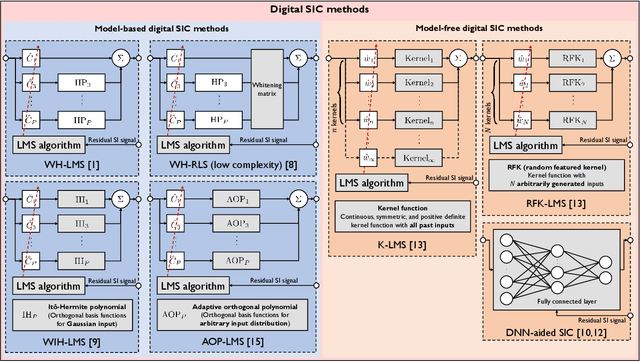
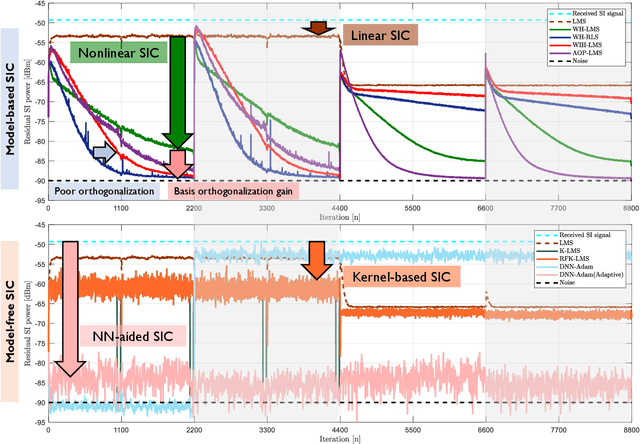
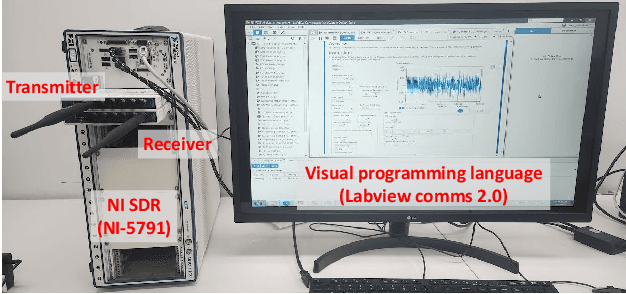
Abstract:Full-duplex communication systems have the potential to achieve significantly higher data rates and lower latency compared to their half-duplex counterparts. This advantage stems from their ability to transmit and receive data simultaneously. However, to enable successful full-duplex operation, the primary challenge lies in accurately eliminating strong self-interference (SI). Overcoming this challenge involves addressing various issues, including the nonlinearity of power amplifiers, the time-varying nature of the SI channel, and the non-stationary transmit data distribution. In this article, we present a review of recent advancements in digital self-interference cancellation (SIC) algorithms. Our focus is on comparing the effectiveness of adaptable model-based SIC methods with their model-free counterparts that leverage data-driven machine learning techniques. Through our comparison study under practical scenarios, we demonstrate that the model-based SIC approach offers a more robust solution to the time-varying SI channel and the non-stationary transmission, achieving optimal SIC performance in terms of the convergence rate while maintaining low computational complexity. To validate our findings, we conduct experiments using a software-defined radio testbed that conforms to the IEEE 802.11a standards. The experimental results demonstrate the robustness of the model-based SIC methods, providing practical evidence of their effectiveness.
Distributed Rate-Splitting Multiple Access for Multilayer Satellite Communications
Jul 14, 2023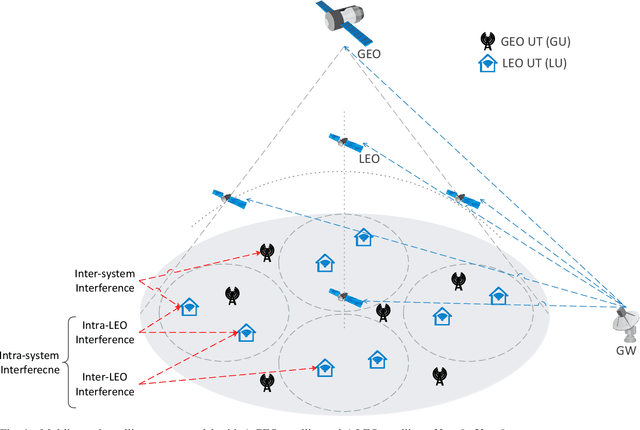
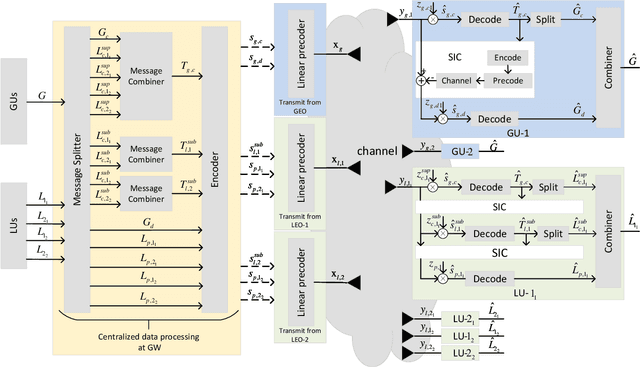
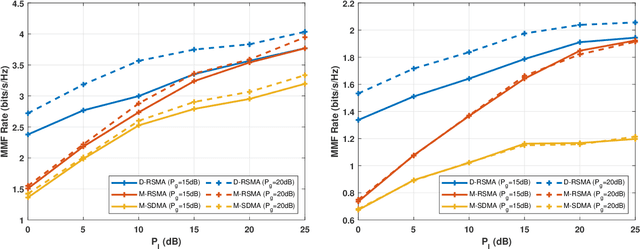
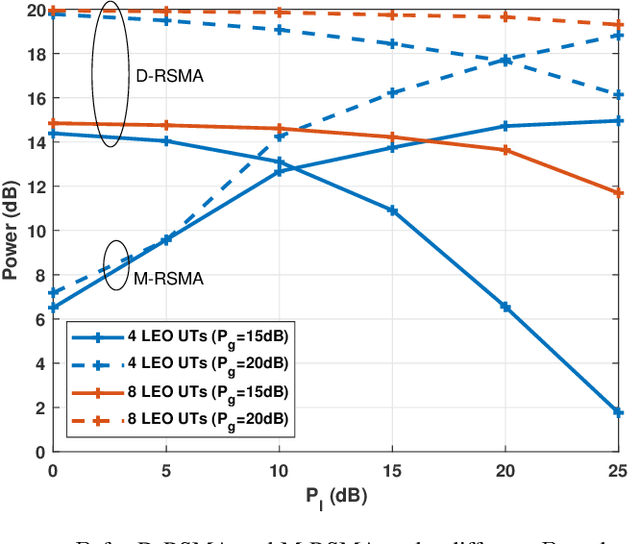
Abstract:Future wireless networks, in particular, 5G and beyond, are anticipated to deploy dense Low Earth Orbit (LEO) satellites to provide global coverage and broadband connectivity with reliable data services. However, new challenges for interference management have to be tackled due to the large scale of dense LEO satellite networks. Rate-Splitting Multiple Access (RSMA), widely studied in terrestrial communication systems and Geostationary Orbit (GEO) satellite networks, has emerged as a novel, general, and powerful framework for interference management and multiple access strategies for future wireless networks. In this paper, we propose a multilayer interference management scheme for spectrum sharing in heterogeneous GEO and LEO satellite networks, where RSMA is implemented distributedly at GEO and LEO satellites, namely Distributed-RSMA (D-RSMA), to mitigate the interference and boost the user fairness of the system. We study the problem of jointly optimizing the GEO/LEO precoders and message splits to maximize the minimum rate among User Terminals (UTs) subject to a transmit power constraint at all satellites. A Semi-Definite Programming (SDP)-based algorithm is proposed to solve the original non-convex optimization problem. Numerical results demonstrate the effectiveness and network load robustness of our proposed D-RSMA scheme for multilayer satellite networks. Because of the data sharing and the interference management capability, D-RSMA provides significant max-min fairness performance gains when compared to several benchmark schemes.
Sum-Rate Maximization of RSMA-based Aerial Communications with Energy Harvesting: A Reinforcement Learning Approach
Jun 22, 2023



Abstract:In this letter, we investigate a joint power and beamforming design problem for rate-splitting multiple access (RSMA)-based aerial communications with energy harvesting, where a self-sustainable aerial base station serves multiple users by utilizing the harvested energy. Considering maximizing the sum-rate from the long-term perspective, we utilize a deep reinforcement learning (DRL) approach, namely the soft actor-critic algorithm, to restrict the maximum transmission power at each time based on the stochastic property of the channel environment, harvested energy, and battery power information. Moreover, for designing precoders and power allocation among all the private/common streams of the RSMA, we employ sequential least squares programming (SLSQP) using the Han-Powell quasi-Newton method to maximize the sum-rate for the given transmission power via DRL. Numerical results show the superiority of the proposed scheme over several baseline methods in terms of the average sum-rate performance.
Rate-Splitting Multiple Access for 6G Networks: Ten Promising Scenarios and Applications
Jun 22, 2023Abstract:In the upcoming 6G era, multiple access (MA) will play an essential role in achieving high throughput performances required in a wide range of wireless applications. Since MA and interference management are closely related issues, the conventional MA techniques are limited in that they cannot provide near-optimal performance in universal interference regimes. Recently, rate-splitting multiple access (RSMA) has been gaining much attention. RSMA splits an individual message into two parts: a common part, decodable by every user, and a private part, decodable only by the intended user. Each user first decodes the common message and then decodes its private message by applying successive interference cancellation (SIC). By doing so, RSMA not only embraces the existing MA techniques as special cases but also provides significant performance gains by efficiently mitigating inter-user interference in a broad range of interference regimes. In this article, we first present the theoretical foundation of RSMA. Subsequently, we put forth four key benefits of RSMA: spectral efficiency, robustness, scalability, and flexibility. Upon this, we describe how RSMA can enable ten promising scenarios and applications along with future research directions to pave the way for 6G.
Indexed Multiple Access with Reconfigurable Intelligent Surfaces: The Reflection Tuning Potential
Feb 15, 2023



Abstract:Indexed modulation (IM) is an evolving technique that has become popular due to its ability of parallel data communication over distinct combinations of transmission entities. In this article, we first provide a comprehensive survey of IM-enabled multiple access (MA) techniques, emphasizing the shortcomings of existing non-indexed MA schemes. Theoretical comparisons are presented to show how the notion of indexing eliminates the limitations of non-indexed solutions. We also discuss the benefits that the utilization of a reconfigurable intelligent surface (RIS) can offer when deployed as an indexing entity. In particular, we propose an RIS-indexed multiple access (RIMA) transmission scheme that utilizes dynamic phase tuning to embed multi-user information over a single carrier. The performance of the proposed RIMA is assessed in light of simulation results that confirm its performance gains. The article further includes a list of relevant open technical issues and research directions.
Flexible Hybrid Beamforming for Spectrally Efficient 6G Joint Radar-Communications
Nov 15, 2022



Abstract:Joint radar-communications (JRC) benefits from multi-functionality of radar and communication operations using same hardware and radio frequency (RF) spectrum resources. Thus JRC systems possess very high potential to be employed into the sixth generation (6G) standards. This paper designs a flexible beamformer for multiple-input multiple output (MIMO) JRC with maximized spectral efficiency (SE). Hybrid beamforming is implemented which constitutes lesser number of RF chains than number of transmitter antennas. We jointly express JRC rate with communication and radar entities including a weighting factor which depicts the dominance of one operation over the other. The joint-SE based proposed method optimally selects the number of RF chains with flexible hynrid beamforming design. Furthermore, when the communication operation takes place the proposed method takes into account the interference occurring from the radar operation and vice-versa. Fractional programming based selection procedure is used for flexible beamforming and optimal number of RF chains while considering interference of each operation. Simulation results are presented and compared with different baselines to show effectiveness of the proposed flexible hybrid beamforming method.
Rate-Splitting Multiple Access for Quantized Multiuser MIMO Communications
Aug 01, 2022
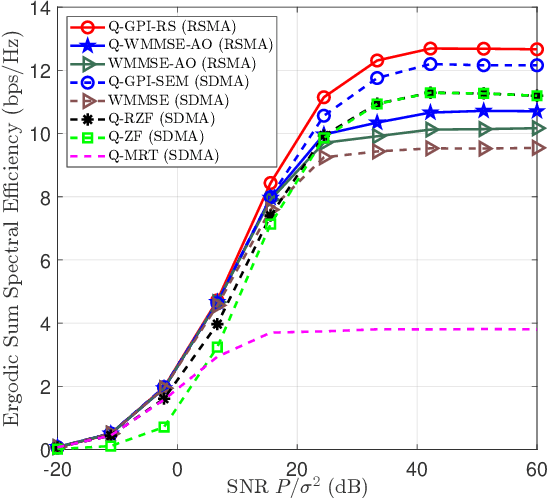
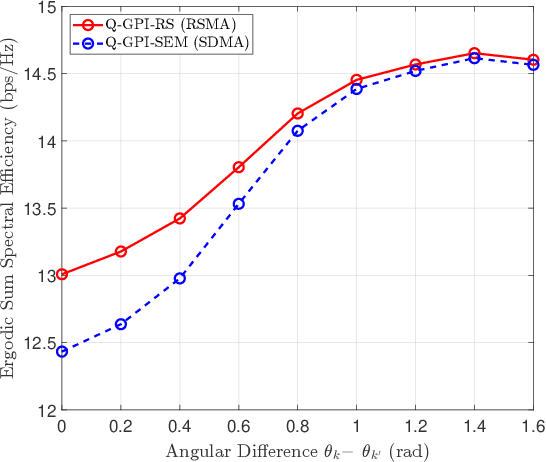
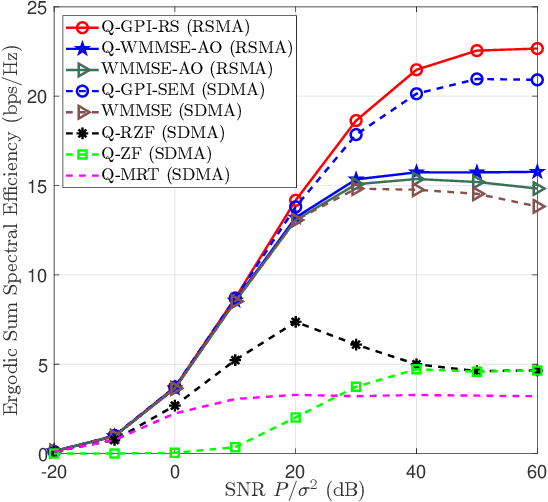
Abstract:This paper investigates the sum spectral efficiency maximization problem in downlink multiuser multiple-input multiple-output (MIMO) systems with low-resolution quantizers at an access point (AP) and users. In particular, we consider rate-splitting multiple access (RSMA) to enhance spectral efficiency by offering opportunities to boost achievable degrees of freedom. Optimizing RSMA precoders, however, is highly challenging due to the minimum rate constraint when determining the rate of the common stream. The quantization errors coupled with the precoders further make the problem more complicated and difficult to solve. In this paper, we develop a novel RSMA precoding algorithm incorporating quantization errors for maximizing the sum spectral efficiency. To this end, we first obtain an approximate spectral efficiency in a smooth function. Subsequently, we derive the first-order optimality condition in the form of the nonlinear eigenvalue problem (NEP). We propose a computationally efficient algorithm to find the principal eigenvector of the NEP as a sub-optimal solution. Simulation results validate the superior spectral efficiency of the proposed method. The key benefit of using RSMA over spatial division multiple access (SDMA) comes from the ability of the common stream to balance between the channel gain and quantization error in multiuser MIMO systems with different quantization resolutions.
 Add to Chrome
Add to Chrome Add to Firefox
Add to Firefox Add to Edge
Add to Edge